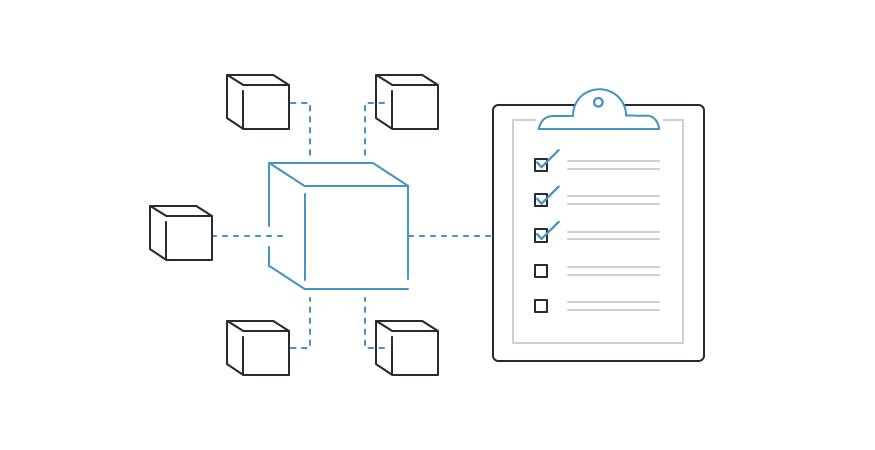
Before we dive into the benefits of creating and polishing a systematic framework, let’s define it, and understand where the concept came from.
What is a Systematic Framework?
A systematic framework is a process that people or machines follow when performing a repeatable activity or activities. Systematic frameworks can be found everywhere and anywhere as they are the most efficient way of providing a consistent high-quality outcome regardless of the person providing the service.
History
Systematic frameworks have been used since the late 18th century when the factory system was introduced. Before then, work was subcontracted out to specialized workshops with skilled workers that required several years of apprenticeship before they could aid production.

The 1st industrial revolution brought about the means to power machinery, and machinery lowered the skill level required for items to be produced. This meant that the division of labor could be reorganized in a manner that was optimized for allowing more people (mainly children and women) to work. Factory owners created systematic frameworks for making textiles, with assembly lines for very specific actions like punching in certain holes, or fastening buttons.

The 2nd industrial revolution gave birth to railroads which ushered in a greater centralization of production. Henry Ford later introduced the moving assembly line, and the World Wars further optimized upon it.

We have arguably gone through a 3rd Industrial Revolution when computers were introduced and many areas of production were relinquished to them. The internet further expanded and is expanding upon this revolution – allowing for efficient communication between people and devices. It ushered in a high level of globalization which is undoing many of the centralized effects of the 2nd Industrial Revolution.
Which brings us to the present-day
Today, systematic frameworks use the best from each of these revolutions in order to provide a consistently high-quality outcome for anything, whether it be hiring or firing an employee, or how to write an article (I know, meta). It brought the division of labor from the first revolution, the efficiency of assembly line work from the 2nd revolution, and the automation and globalization from the 3rd revolution together into a nice little package.
You see systematic frameworks every day. Whether it’s the maid at a hotel following a checklist to clean your room, or the McDonalds making sure every burger comes out tasting and looking exactly the same across their 38,000 restaurants in 118 countries.
Despite these benefits, small businesses across the world seem like they have completely ignored the industrial revolutions. They are a throwback to the middle ages, and tend to rely heavily on their skilled employees, have very little systematic division of labor, and have poor communication and little automation. Because of this, they are unable to scale.
Here are 6 benefits you can experience by using a systematic framework within your small business:

1. Systematic frameworks are consistent and maintain a certain standard of quality
When a system is followed by every employee within a given role, then every customer will have the same high-quality experience, and every employee will be treated fairly and judged objectively.
2. You will save money and time
Systematic frameworks make training easy. You can create standard operating procedures and videos one time, and employees will know exactly how work should be done as there are objective measures for quality assurance.
Proper systems design seeks to understand which pieces of tasks can be automated, which are commodities, and which require truly unique talent. This means existing processes that utilize key talent can be broken up into ways that lean more on automation and entry-level or offshore tasks.
3. You can identify weaknesses in your business and address them instantly
A properly built systematic framework has clear key performance indicators that are collected automatically. This allows you to easily identify if any piece of a system is not working properly and make changes to improve it. It also allows you to see if any employees are under-performing by comparing their metrics vs others. On the flip side, you can see your top performers and understand what they are doing differently. You can then further polish the system to model them.
4. Failure becomes something good and needed
People do not have a good relationship with failure, but you can change this if your business culture treats it as a failure of a system as opposed to the failure of an individual. When a business embraces the fact that progress often results in failure, you will be able to test out more things and adapt faster than your competitors.
5. Scalability
Using systems you can do repeatable tasks thousands of times as your systems hire, onboard, train, perform and review on their own. This opens your business up to opportunities for regional expansion or franchising – and even if that’s not of interest to you it does contribute to #6.
6. Your company can be sold much more easily, and at a higher multiple of earnings
Absentee-owner businesses with systematic frameworks sell for 30-50% more than businesses with owner-operators and are sold much more easily.
How Acquira creates departmental frameworks

Acquira exists to systematize small businesses. At Acquira we have built frameworks around our businesses, and each framework contains an overarching philosophy, policy, and procedure (the 3 P’s). It also contains a blueprint (which is a master list of procedures and checklists).
The following are the departments or “work zones” that we feel apply to all businesses along with some fundamental questions around each. When we invest in a business, it is under the expectation that all the following items will be well addressed within the first year of acquisition. Our acceleration program makes sure of it.
Vision, goal-setting, strategy, decision-making & review
- What are your company's core values/DNA?
- What are the flywheels and 20 mile marches that make up the business?
- Where is the company going in 10+ years and how are they getting there?
- How does this influence decision-making for the year, quarter, month, week and day?
- What are the constraints around planning new projects?
- How do you review projects and adapt your systems based on successes and failures?
Organization & communication
- How is the company structured? What is each role and job description, and each role's KPIs (Key Performance Indicators)?
- How does each team member like to work? How do they hate to work? Put together a 1-pager for each member.
- Who reports to whom? How often do they meet and how is that meeting structured (meeting rhythms)?
- What does each department's scorecard look like (most important numbers to track)?
- What ERP (Enterprise Resource Planning) software is used, and who uses it?
- What project management tools are used and who uses them?
Human resources
- What is the policy and procedure around hiring?
- How are new employees onboarded and trained? What does their first 100 days look like?
- How are new managers onboarded and trained (esp. when an employee is promoted to a management position for the first time)? What do their first 100 days as a manager look like?
- What benefits and comp does each employee have?
- How are performance reviews handled?
- How do you admonish employees?
- How do you praise good work?
- On what criteria and how are promotions and demotions handled?
- On what criteria and how do you let employees go?
Finance
- What systems and policy will be in place to review expenses and AR to assure the company is cashflow positive and has sufficient cash float?
- What mandates exist to ensure distributions, cash float and growth investment are well balanced? How often do you adjust these mandates?
- What are the corporate hygiene systems to ensure data rooms are always up to date in case of exit, loan, or investment?
Marketing
- What is your USP (Unique Selling Proposition) and value exchange, and how are you consistently communicating this with customers throughout their lifecycle?
- Have you identified and tested the ideal price point for products/services?
- Have you created a brand and tagline that captures mindshare of customers (when you hear the word Acme, does your customer think, “Widgets!”)?
- Have you outlined the first 100 days of your customer's journey, and included 3-4 elements of surprise and delight in various mediums (hand-written letters, gifts, videos, voicemail, email, etc).
- Do you understand each niche demographic of your customer base through the use of avatars/personas, what motivates them? Do you know how large their serviceable market is today, and how large it might be in 10 years?
- Have you identified where the customers in each niche demographic congregate?
- Have you come up with marketing plans for each niche demographic?
Operations & sales
- Training around Vetted ERP systems
- Systems for generating quotes
- Systems for overseeing sales pipelines
- Product/service fulfillment and all systems within
- Overseeing customer support and all systems within
- Overseeing quality assurance and all systems within
- All systems to carryout marketing plans
It is our hope that this post has convinced you of the need for systematic frameworks within small businesses. In the following months, we will be releasing more content that will go into more detail about how to create frameworks in each department.
I'm sold! What's the next step?
If you would like to work with us on an acquisition, please apply here.
Acquira specializes in seamless business succession and acquisition. We guide entrepreneurs in acquiring businesses and investing in their growth and success. Our focus is on creating a lasting, positive impact for owners, employees, and the community through each transition.



